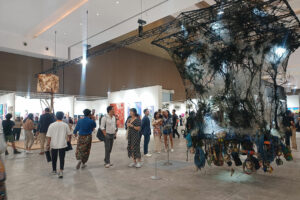AS Art Jakarta settled down in its new home at the JIExpo Kemayoran — a large convention space with high ceilings that it moved into last year — the fair expanded in size by 20% by occupying two more halls.
This allowed them to increase the number of exhibitors to 73 from 68 last year, with art galleries coming from all over the world to participate. It also boasted more corporate sponsorships from the likes of financial company UOB Indonesia and stock investing app Bibit-Stockbit, who collaborated with artists to put up elaborate displays.
Art Jakarta was held last weekend, from Oct. 4 to 6.
“We made the right decision with the spacious setting, all within a single compact hall, allowing us and our exhibitors to grow not only in size, but in substance,” said Tom Tandio, fair director of Art Jakarta, in a speech on opening day.
“This enhancement offers an experience at par with other global art events,” he told BusinessWorld later. “And rightly so, because the art markets in Southeast Asia are all growing.”
The biggest downside to this venue would be its location north of central Jakarta, which meant braving traffic jams when coming from the city. This was made worse on the Saturday of the event, as the Indonesian military held a parade that citizens only found out about days before.
ON CULTURE AND CLIMATEDespite the severe traffic, JIExpo served its purpose as a large-scale venue, the curated Spot section right in the middle being the most notable beneficiary of the expansion. There, Indonesian artists put up giant, striking installations that commented on sociopolitical and environmental realities.
Timoteus Anggawan Kusno’s Dismantling Nostalgia, a 13-plus-foot-tall canvas that collaged prints of romantic rural landscapes of Indonesia (known as mooi indie, or “beautiful Indies”) highlighted how Dutch colonial propaganda became a bedrock of misplaced Indonesian patriotism.
Nearby, former art professor Tisna Sanjaya’s Ganjel was a clear jab at modern politics, made up of a stack of orange binders with sculptures of President Jokowi and his eldest son Gibran Rakabuming Raka atop (the latter is set to become vice-president this year following a change in rules that allow those under 40 to take office). The monument to political nepotism and flawed bureaucracy was surrounded by a handful of grotesque paintings.
On the other end of the central Spot space were angular tree roots holding up a wooden block, a piece by Syaiful Garibaldi named Antara Muara, modeled after traditional stilt houses and made of leftover wood and leather. The work was an homage to mangroves in coastal villages that protect against erosion. Finally, Iwan Yusuf’s Air Pasang presented a chaotic cluster of fishing nets and sea debris strung up above, a recreation of the waste brought to shore by the ocean’s currents.
All four installations were commissioned just for the fair, “evidence of the rich goldmine of artistic expression that Indonesia can offer,” said Mr. Tandio.
“Together, we strive to provide artists and creative minds a unique platform to present their creations and to showcase Indonesia’s growing importance in the regional and international art worlds,” he explained in his opening speech.
COLLABORATION IS KEYMr. Tandio told BusinessWorld that showing off local artists at a big platform is not enough. “Collaboration is key,” he said. “We work with other art fairs like in South Korea; we have program exchanges. For the galleries, I introduce Indonesian galleries abroad and foreign galleries here.”
One of Jakarta’s leading galleries, ROH Projects, had several booths showing a variety of works, like Aurora Arazzi’s paper creation that gives the illusion of a bread crust abandoned on a tile, and Yogyakarta-based Eko Nugroho’s stunning monochrome paintings.
In contrast, the most minimalist booth was easily ShanghART Singapore’s. It presented New Forest, a nondescript newspaper stand installation amid the hustle and bustle of the fair, designed by Robert Zhao who represented Singapore at the Venice Biennale this year. It sold printed news posters that reported on a tree stump felled by a monsoon, the product of Mr. Zhao’s research project that followed the decay of the tree trunk via motion camera.
For Mr. Tandio, the increased size of Art Jakarta and consistent quality of works being exhibited show just how much the art market continues to grow. He also pointed out numerical proof of it (though they do not release sales numbers): from 32,000 visitors in 2022, they attracted 35,578 visitors in 2023. Days after the event, Art Jakarta notified BusinessWorld that the 2024 edition saw 38,368 visitors. For the fair, founded in 2009 by Mugi Rekso Abadi (MRA) Media, this “reaffirms its position as Indonesia’s flagship art event.”
“Ultimately, I believe in collaborations to promote art all over Asia,” Mr. Tandio said. “That is why Art Jakarta is an Asian-focused art fair.” — Brontë H. Lacsamana
